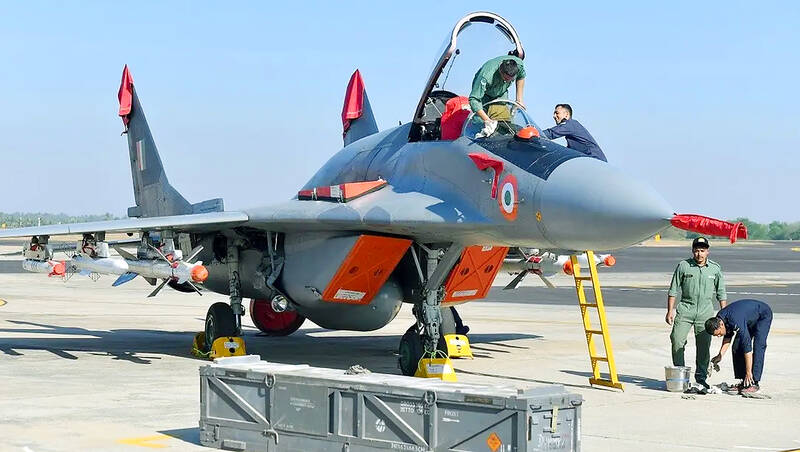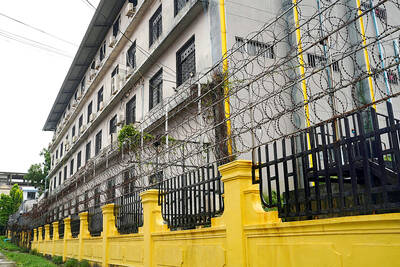Two people on the ground died after a Russian-made MiG-21 military aircraft crashed onto a house in India yesterday, police said.
“Pilot has been rescued safely. The MiG crashed on a house. Two people have died. Three people have been injured,” police officer Sudhir Chaudhary told reporters after the crash in the western state of Rajasthan.
The Indian Air Force (IAF) confirmed the crash and that the pilot ejected.

Photo :AFP
“A MiG-21 aircraft of the IAF crashed near Suratgarh during a routine training sortie today morning,” the IAF wrote on Twitter. “The pilot ejected safely, sustaining minor injuries. An inquiry has been constituted to ascertain the cause of the accident.”
Two pilots were killed in July last year when a MiG-21 crashed in a training sortie in Rajasthan. That crash was the sixth MiG-21 aircraft to have gone down since January 2021, with five pilots killed.
Russian-made MiG-21 jets first entered Indian service in the 1960s and for decades served as the backbone of the nation’s air force.
However, numerous crashes in the past few decades have led to the planes being dubbed “flying coffins,” due to their poor safety record.
An army helicopter with three people on board last week crashed in the Jammu and Kashmir region. Two IAF jets crashed in January, killing one pilot and injuring two others, in an apparent midair collision while on exercises south of the capital, New Delhi. The incident involved a Russian-made Sukhoi Su-30 and a French-built Mirage 2000.
Five Indian soldiers were killed in October last year when their helicopter crashed in Arunachal Pradesh state, near India’s militarized and disputed border with China.
It was the second military chopper crash in the state that month, coming weeks after a Cheetah helicopter came down near the town of Tawang, killing its pilot.
Indian Chief of Army Staff General Bipin Rawat was among 13 people killed when his Russian-made Mi-17 helicopter crashed while transporting him to an air force base in December 2021.
India is investing billions of dollars in modernizing its military, an initiative motivated by its decades-old rivalry with Pakistan and increased tensions with China.
It has also sought to diversify away from Russia, with the IAF buying dozens of French Rafale jets, with deliveries starting in 2020. New Delhi is also investing heavily in developing its own defense industry.
India opened its largest helicopter manufacturing plant in February, months after it unveiled its first locally made aircraft carrier and test-fired a ballistic missile from its maiden domestic nuclear-powered submarine.
At the same time, it has been trying to sell more of its locally produced hardware to countries looking for lower-cost alternatives to Western-made equipment.

Drug lord Jose Adolfo Macias Villamar, alias “Fito,” was Ecuador’s most-wanted fugitive before his arrest on Wednesday, more than a year after he escaped prison from where he commanded the country’s leading criminal gang. The former taxi driver turned crime boss became the prime target of law enforcement early last year after escaping from a prison in the southwestern port of Guayaquil. Ecuadoran President Daniel Noboa’s government released “wanted” posters with images of his face and offered US$1 million for information leading to his capture. In a country plagued by crime, members of Fito’s gang, Los Choneros, have responded with violence, using car

Two former Chilean ministers are among four candidates competing this weekend for the presidential nomination of the left ahead of November elections dominated by rising levels of violent crime. More than 15 million voters are eligible to choose today between former minister of labor Jeannette Jara, former minister of the interior Carolina Toha and two members of parliament, Gonzalo Winter and Jaime Mulet, to represent the left against a resurgent right. The primary is open to members of the parties within Chilean President Gabriel Boric’s ruling left-wing coalition and other voters who are not affiliated with specific parties. A recent poll by the

The team behind the long-awaited Vera Rubin Observatory in Chile yesterday published their first images, revealing breathtaking views of star-forming regions as well as distant galaxies. More than two decades in the making, the giant US-funded telescope sits perched at the summit of Cerro Pachon in central Chile, where dark skies and dry air provide ideal conditions for observing the cosmos. One of the debut images is a composite of 678 exposures taken over just seven hours, capturing the Trifid Nebula and the Lagoon Nebula — both several thousand light-years from Earth — glowing in vivid pinks against orange-red backdrops. The new image

CYBERCRIME, TRAFFICKING: A ‘pattern of state failures’ allowed the billion-dollar industry to flourish, including failures to investigate human rights abuses, it said Human rights group Amnesty International yesterday accused Cambodia’s government of “deliberately ignoring” abuses by cybercrime gangs that have trafficked people from across the world, including children, into slavery at brutal scam compounds. The London-based group said in a report that it had identified 53 scam centers and dozens more suspected sites across the country, including in the Southeast Asian nation’s capital, Phnom Penh. The prison-like compounds were ringed by high fences with razor wire, guarded by armed men and staffed by trafficking victims forced to defraud people across the globe, with those inside subjected to punishments including shocks from electric batons, confinement